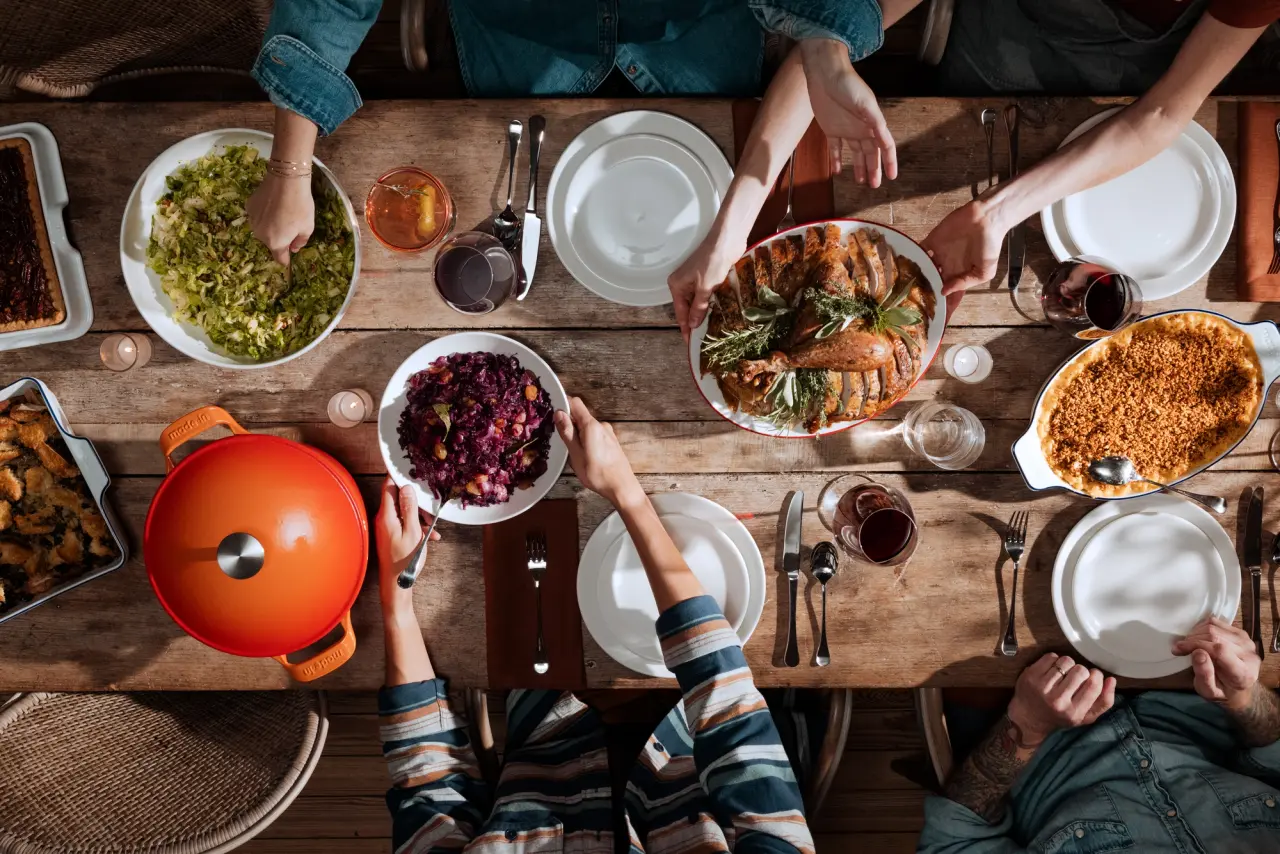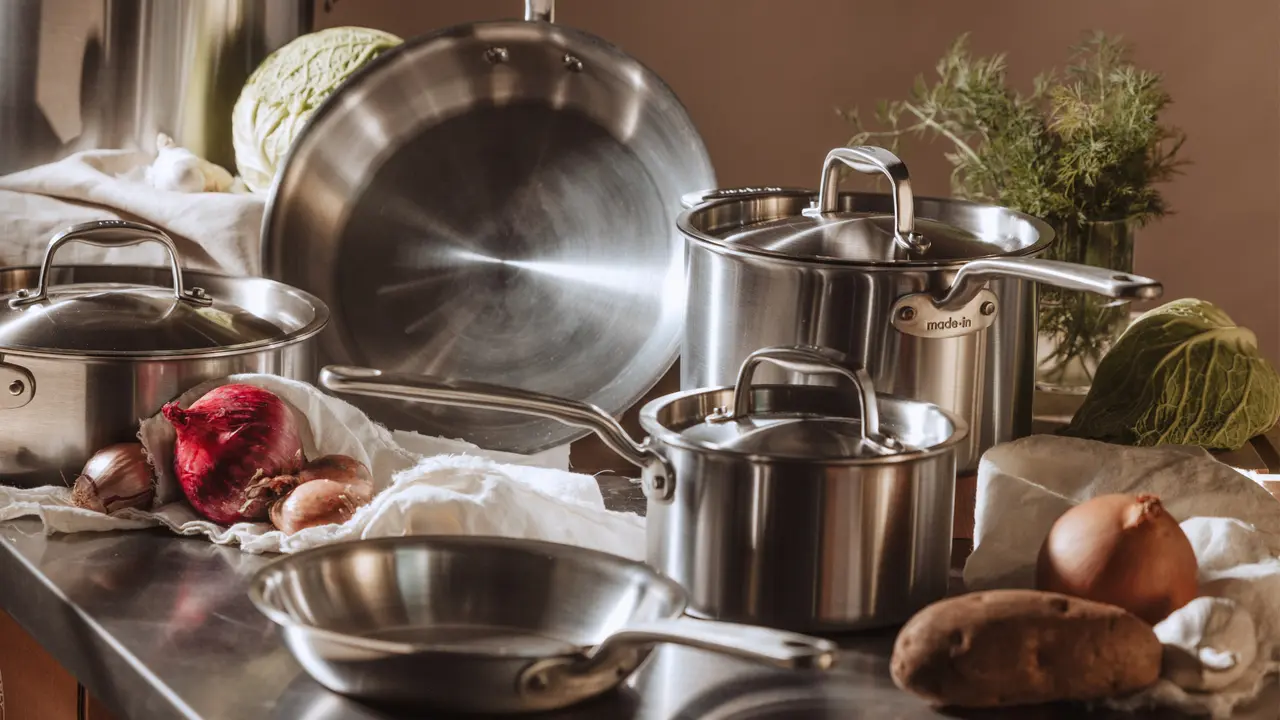The concept of a “proper” way to set the table may seem unnecessarily fussy and overly formal, but it’s much more manageable—and practical—than it seems. From salad fork to charger plate, each item’s placement is based on when and how it will be used, making the table setting a matter of logic and functionality rather than aesthetics (though it does add a certain elegance to your dinner party setup, as a bonus).
By learning how to set a table the right way, you also set yourself, your dinner parties, and any approaching holiday meals up for success. Keep reading for a few easy to remember rules and suggested guidelines.
The Basics: How to Set a Table Correctly

How you set your table will vary depending on the occasion and mood of the event you’re hosting, but there are a few key placements that will almost always stay the same.
Flatware
Only include silverware settings required for the meal or courses you’re serving. In other words, if you aren’t serving dessert, then there’s no need for a dessert spoon to be on the table.
Salad and dinner forks are placed to the left of the plate, with the salad fork being the furthest to the left. The right side of the plate is immediately flanked by the dinner knife (with the blade pointing toward the plate), followed by the soup spoon.
This placement is determined by the logical progression of the meal—the simple rule of silverware etiquette is you work your way through the flatware towards the plate on either side.
- First the soup, using the spoon to the far right.
- Followed by a salad, using the fork all the way at the far left.
- Finally, the main course requires the dinner fork and dinner knife, the two innermost utensils.
Maximalist table settings include a smaller butter knife laying across its very own bread and butter plate, just above the forks. Its blade should be facing you with the tip pointed left. A dessert course necessitates either a dessert spoon (also pointed left, located right above the dinner plate) or a dessert fork (just above the dessert spoon, but with tines to the right).
Napkins
Napkins can be laid out in one of two ways. The first and most common way to present a napkin is to fold it in half and place it underneath the fork(s) to the left of the plate. Otherwise, napkins may be bound with a napkin ring and presented on top of a charger plate (a large decorative plate that functions similarly to a placemat).
The first is how most of us present napkins at home, and the second is more common at fine dining establishments, banquets, weddings, or other highly formal meals.
Some hospitality professionals prefer to present the napkin on a plate in order to reduce the disruptions of dropped forks and clinking flatware as guests extract their napkins, but both are completely acceptable.
Plateware
At its most basic, a dinner plate goes right in the center of your table setting, forks to the left and spoons/knives to the right. For multicourse meals, additional plateware is ordered by course.
Salad plates go on top of dinner plates, and soup bowls sit on salad plates—all organized so you can work your way down the stack as the meal progresses. In other words, once you finish your soup, you unlock the next level: salad. Soup bowls and salad plates are removed at the end of each course.
Bread and butter plates go just above the forks, slightly indented so they’re equidistant from both the dinner plate and the top of the napkin. If you’re using a charger plate, this sits directly underneath the dinner plate and stays in the same place throughout the meal.
Drinkware
Water glasses are centered above the knife. If only one wine is being served, either a red or white wine glass is placed to the right of the water glass. It should be pushed very slightly back, towards the center of the table. If you’re serving both red and white wine, the red wine glass will occupy that spot (slightly northeast of the water glass). White wines are usually earlier in the meal, so your white wine glass is situated nearer to you and centered between the water glass and red wine glass.
This creates a beverage trifecta, in which the bottom of the white wine glass is in line with the tip of the dinner knife. If there are going to be toasts, coupes or Champagne glasses are the farthest to the right—this makes it easier for guests to raise their glasses.
Proper Table Setting Protocols: Basic, Casual, and Formal

Setting a proper table is an easy way to set the mood for your meal. There are a few different ways to do this depending on the level of formality of your meal.
Basic Dinner Setting
The table setting we use most often is also the easiest. Think of this as your foundation. It’s perfect for everyday meals, and can easily be built upon for more elaborate menus.
- Center a dinner plate on the place mat or tablecloth.
- Place a folded napkin to the left, with a dinner fork centered on top. To the right, place a dinner knife with its blade facing inwards. To the right of that, place a soup spoon.
- Set a drinking glass between the dinner plate and dinner knife.
Casual Dinner Setting
Perfect for dinner parties ranging from casual to elaborate, casual dinner settings require a few different types of plates, most of which are standard pieces in home kitchens.
- Center a dinner plate on the place mat or tablecloth. Place a salad plate, and then a soup bowl, on top of the dinner plate.
- Place a folded napkin to the left, with a dinner fork centered on top. To the right, place a dinner knife with its blade facing inwards. To the right of that, place a soup spoon.
- Shift the drinking glass to be centered above the knife.
- Place a wine glass slightly northeast—or up and to the right—of the drinking glass.
Formal Dining Setting
This elaborate set-up is typically reserved for formal dinners at weddings and other major events. It requires a full Tabletop Set, but despite all the moving pieces (literally) it’s intuitive once you consider the logic.
- Center a dinner olate on a charger plate or place mat. Place a salad plate, and then a soup bowl, on top of the dinner plate.
- Place a folded napkin to the left, with a dinner fork centered on top. To the right, place a dinner knife with its blade facing inwards. To the right of that, place a soup spoon.
- Shift the drinking glass to be centered above the knife.
- Place a red wine glass very slightly northeast of the drinking glass, and a white wine glass in front of/in between them. All three should be easily accessible.
- Place a dessert spoon (pointing left) above the dinner plate.
- Up and to the left of the dinner plate, place a bread and butter plate. Lay a butter knife across it, also pointing left.
- Place cards should be centered just above the dessert spoon, with names written on both sides. Flank the place card holder with a salt shaker to the left and a pepper shaker to the right.
What Should You Set the Table With?

If you’re going to take the time to set a proper table, do so with beautifully made pieces. Across our Dinnerware, we work with manufacturers in Stoke-on-Trent, England, where the local pottery tradition extends all the way to the 1600s. Usually made only for restaurants, we’re the first and only to offer this durable, elegant and chip-resistant china Plateware to home cooks.
Our Flatware is crafted in Italy and used in restaurants worldwide. Our manufacturing partners have centuries of expertise—in which time they’ve developed proprietary technologies for improved durability and corrosion resistance.
Our Wine Glasses are blown in Germany, featuring durable two-piece construction (meaning fewer weak points typical of three-piece construction) and a proprietary shape, ensuring each varietal gets a chance to shine.
Ready to Cook?
When it comes down to it, setting the table is also setting the tone. The most expedient way is to combine the Tabletop Set, a 41-piece set including Flatware, four each of all our Plateware, and a Serving Platter, with the 12-piece Glassware Set.
Not only is each individual piece crafted by expert artisans, but the Set is designed to create an overall effect that’s striking and refined. So now that you know how to arrange it, it’s time to find your perfect table setting.
































